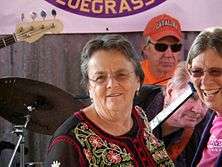Lisa Law

Lisa Law is an American photographer and filmmaker best known for her photographic chronicles of the counterculture era. Law is also the author of the book and documentary film Flashing on the Sixties.[1]
Law's career as a photographer began in the early sixties. She landed a job with as an assistant to the manager of the Kingston Trio, Frank Werber, who gave her a used Honeywell Pentax camera. She began taking pictures of the musicians in the thriving music scene in the Bay Area and Los Angeles
Whether Law was backstage with The Beatles, Peter, Paul and Mary, The Kingston Trio, We Five, Otis Redding, The Lovin Spoonful, The Velvet Underground, The Byrds, taking promotional photographs of Janis Joplin and Big Brother, or at home making dinner for house guests like Bob Dylan or Andy Warhol or helping feed hundreds of thousands at Woodstock with the Hog Farm commune, her passion for photography grew into a profession.
After living in Yelapa, Mexico for a short time in 1966, Law chronicled the life of the flower children in Haight Ashbury. She carried her camera wherever she went, to the Human Be-In and the anti-Vietnam march in San Francisco, Monterey Pop Festival, and meetings of The Diggers. Law then joined those who migrated to the communes of New Mexico in the late Sixties and early Seventies. She and her former husband, Tom Law, whom she met in 1965 at a Peter Paul & Mary concert in Berkeley, CA, lived together on a farm in Truchas, New Mexico for 12 years and had four children, Dhana Pilar, Solar Sat, Sunday Peaches & Jesse Lee Rainbow. Tom's late brother was the actor John Phillip Law.
Since that time, Lisa Law has specialized in documenting history as she has experienced it. As a mother, writer, photographer and social activist, her work reveals distinctive communities of people, including the homeless of San Francisco, the El Salvadorian's resistance against military oppression, the Navajo and Hopi nations struggling to preserve their ancestral religious sites, traditions and land. She uses her camera as a peaceful weapon to champion the rights of indigenous nations, bringing to a wide audience riveting insights into their cultures just as she did during the social revolution of the Sixties.[2]
Books
- Flashing on the Sixties, Squarebooks, Santa Rosa, CA, 1987
- Interviews with Icons: Flashing on the Sixties, Lumen Books, Santa Fe New Mexico, 2000
Books that include Law's photographs
- Beneath the Diamond Sky: Haight-Ashbury 1965-1970, Barney Hoskins, Simon & Schuster Editions, 1997
Documentaries
- Flashing on the Sixties: A tribal document by Lisa Law, Flashback Productions Ltd. 1994
Covers
DVD cover photograph
- Flashing on the Sixties: A tribal document by Lisa Law, Flashback Productions Ltd. 1994
CD cover photographs
- Dezeo: Jewish Music From Spain by Consuelo Luz, Wagram Music, 2000
References
External links
- A Visual Journey - Photographs by Lisa Law 1965-1971 Lisa Law Smithsonian Institution Exhibition
- Lisa Law at the Internet Movie Database